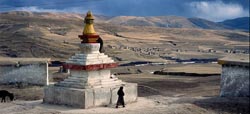Recent decades likely wettest in four millennia in Tibet

Photo: taken by Jialiang Gao on the Tibetan Plateau<br>
Researchers looked at 3,500-year-long tree ring records from North East Tibet to estimate annual precipitation. They found that recent decades have likely been the wettest on record in this semi-arid region.
The precipitation records have been reconstructed using sub-fossil, archaeological and living juniper tree samples from the north-eastern Tibetan Plateau. They reveal a trend towards wider growth rings, implying moister growing conditions – with the last 50 years seeing increasing amounts of rainfall.
Notable historical dry periods occurred in the 4th Century BC and in the second half of the 15th Century AD.
Dr Tim Osborn from UEA’s Climatic Research Unit said: “Our collaboration with scientists from China has been very fruitful, leading to what is currently the longest tree-ring-width record in the cold and arid north-eastern Tibetan Plateau. Not only is the record very long, it is based on samples from more than 1000 trees, some of which have an individual lifespan of more than 2000 years. These are among the longest-lived trees in the world.”
Not only are these trees long-lived, but they are useful for understanding how climate has changed. The widths of the tree rings show a close correspondence with observations from rain gauges over the last 55 years, such that tree rings in wetter years tend to be wider than tree rings in drier years.
Dr Osborn said: “The most recent few decades have, on average, the widest rings in the 3,500-year record which suggests that this may have been the wettest period, perhaps associated with global warming during the last century. Indeed, over the last two thousand years when the Northern Hemisphere is warm it appears to be wetter in the Mountains of North East Tibet. This suggests that any further large-scale warming might be associated with even greater rainfall in this region – though we note that other factors could also have contributed to the increased ring widths.”
‘A 3500-year tree-ring record of annual precipitation on the north-eastern Tibetan Plateau’ is published in Proceedings of the National Academy of Sciences.
Media Contact
All latest news from the category: Earth Sciences
Earth Sciences (also referred to as Geosciences), which deals with basic issues surrounding our planet, plays a vital role in the area of energy and raw materials supply.
Earth Sciences comprises subjects such as geology, geography, geological informatics, paleontology, mineralogy, petrography, crystallography, geophysics, geodesy, glaciology, cartography, photogrammetry, meteorology and seismology, early-warning systems, earthquake research and polar research.
Newest articles

Properties of new materials for microchips
… can now be measured well. Reseachers of Delft University of Technology demonstrated measuring performance properties of ultrathin silicon membranes. Making ever smaller and more powerful chips requires new ultrathin…

Floating solar’s potential
… to support sustainable development by addressing climate, water, and energy goals holistically. A new study published this week in Nature Energy raises the potential for floating solar photovoltaics (FPV)…

Skyrmions move at record speeds
… a step towards the computing of the future. An international research team led by scientists from the CNRS1 has discovered that the magnetic nanobubbles2 known as skyrmions can be…




















